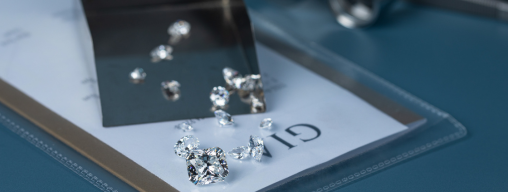Previous
Diamond Shapes
One of the key elements that set different diamond…
When it comes to purchasing a diamond, ensuring its quality, authenticity, and value is paramount. Diamond certificates offer valuable insights into a stone's characteristics and grading amidst a plethora of options.
Diamond certificates play a crucial role in providing transparency and assurance to consumers. By undergoing rigorous examination by expert gemologists using specialised equipment, diamonds are meticulously evaluated and graded according to standardised criteria.
While grading reports are essential, they may not capture a diamond's true beauty, only perceptible to the eye. We advise against solely relying on reports, as diamonds with identical grading can differ significantly. At Kayes, we encourage viewing diamonds firsthand. Acknowledging your personal preferences and emotional connections are vital in selection.
A diamond certificate, also known as a diamond grading report, is an official document issued by an independent gemological laboratory.
It serves as a detailed analysis of a diamond's key characteristics, including its cut, colour, clarity, carat weight, and sometimes additional factors such as fluorescence and symmetry.

When purchasing a certified diamond, it's crucial to ensure that the grading report comes from a reputable and independent gemological laboratory. When reviewing a diamond certificate, pay attention to the following key elements:
Grading Details
Examine the carat weight, colour, clarity and cut grades to understand the diamond's quality and value. For more information on the 4C's read our Diamond 4C's Guide.
Carat Weight
Carat weight measures the size of a diamond. While larger diamonds are often more valuable, it's essential to consider other factors such as cut, colour, and clarity to determine overall quality and value.
Colour
Diamond colour is graded on a scale from D (colourless) to Z (light yellow or brown). The less colour a diamond exhibits, the higher its colour grade.
Clarity
Clarity refers to the presence of internal and external imperfections, known as inclusions and blemishes, within a diamond. The clarity grade assesses the diamond's purity, with higher grades indicating fewer imperfections.
Cut
The cut grade assesses the quality of a diamond's proportions, symmetry, and polish. A well-cut diamond maximises brilliance, fire, and sparkle, making it more visually appealing.
Additional Grading Information
Polish
Smoothness of the diamond’s surface, assessed on a scale ranging from
Excellent to Poor.
Symmetry
Exactness of the diamond’s outline, and the shape, placement, and alignment
of its facets, assessed on a scale ranging from Excellent to Poor.
Fluorescence
Note any fluorescence present in the diamond, as it can affect its appearance under certain lighting conditions.
Inscriptions
Any text, symbols and the unique GIA report number which inscribed on the diamonds girdle.
Additional Comments
Review any additional comments or remarks provided by the gemologist, as they may offer insights into the diamond's unique characteristics.
In the world of diamonds, knowledge is power. Allow our diamond experts to be your trusted companions, ensuring you navigate the extensive array of options with confidence. Whether you're searching for an engagement ring, anniversary gift, or personal indulgence, together, we'll help you select a diamond that aligns perfectly with your personal preferences and budget.
Have A Question?